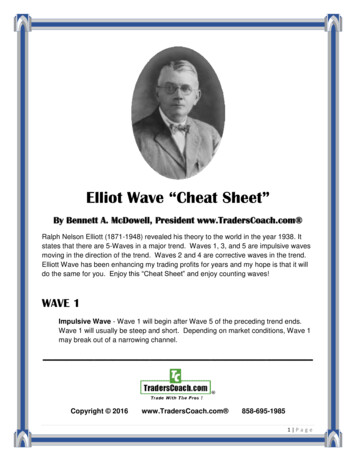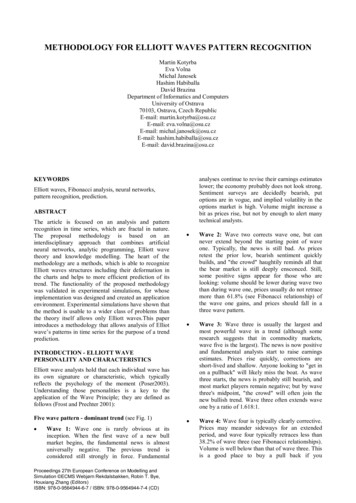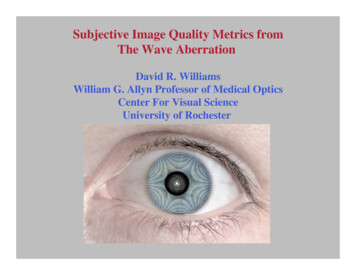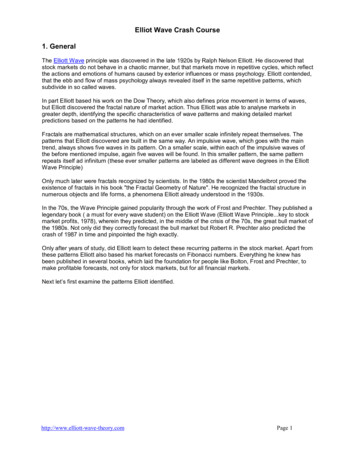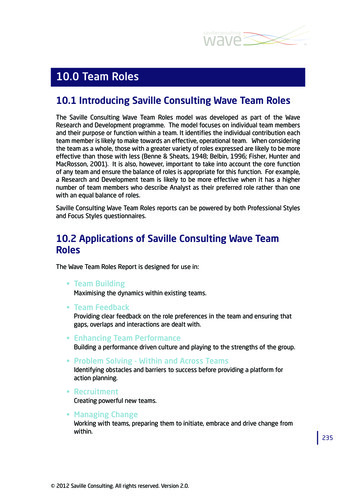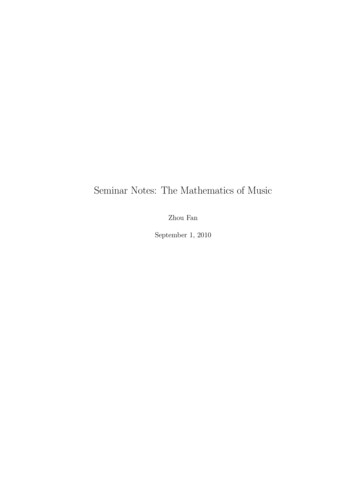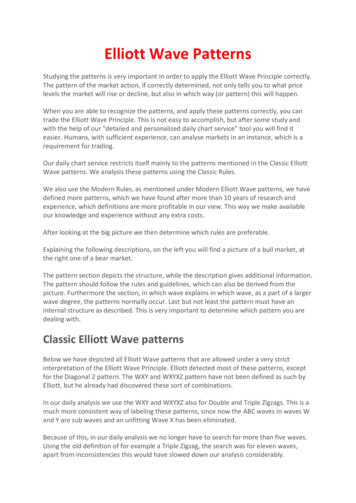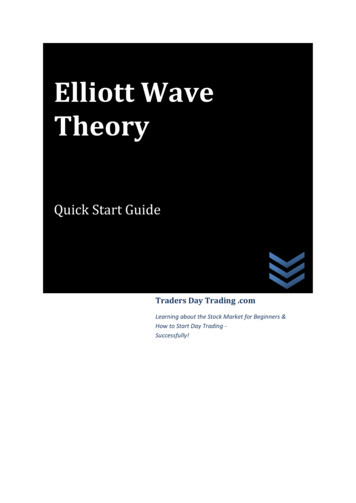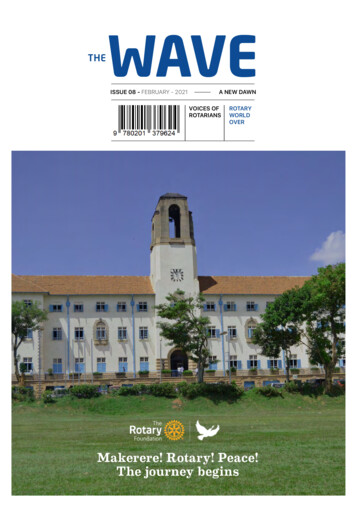
Transcription
THEWAVEISSUE 08 - FEBRUARY - 2021A NEW DAWNVOICES OFROTARIANSROTARYWORLDOVERMakerere! Rotary! Peace!The journey beginsFebruary 2021 The Wave 1
Inside the Waveo5 Editor’s NoteCelebrate the Makerere University Rotary Peace Centreo7 President Rotary International’s MessageHolger Knaacko8 District Governor’s MessageRosetti Nabbumba Nayenga10 Foundation Trustee Chair’s MessageK. R. Ravindran1110Our voice, vote and vocation can promote peace.Rtn. Dennis Wong12 The relationship between Peace, Rotary and UNESCOPAG Jones Kyazze14 Peacebuilding Clubs: A blossoming dreamRtn. Alison Sutherland16 2021 Rotary Peace FellowsRtn. Godfrey Mukalazi1923 Gear up for a youth peace hub in Northern Uganda2024 Kasule - An advocate for the rights of PWDsOcen Ivan Kenneth31Ronald Kasule26 We all appreciate peace, but why do we promote conflict?Emilian Kayima3728 Moshi’s Rotary Peace Garden: A beacon of hopeRtn. Francis R. Selasini33 Tell Rotary stories, createimpact40 RC Kabulasoke-Gombareaches out to health centres34 From disaster to a miracle:Overcoming physical.41 So long President AbelMbilinyi39 Ukonga Rotary Club’sroad to charter44 Lessons from Rtn.Robinah Lubwama’s life51Applications OngoingMakerere University Rotary Peace Centre45 RC Tanga Centraldonates maternity kits toMikanjuni Hospital47 Mission Green: Rotaractclubs plant 10,000 treesin Western Uganda35February 2021 The Wave 345
Editor’s NoteCelebrate the Makerere University Rotary Peace CentreFellow Rotarians and our friends,This editorial was written at the time when Uganda was undergoing aPresidential and Parliamentary election. The tension preceding this processnotwithstanding, we largely had a peaceful election. This was indeed a goodtime to reflect on the theme for this month - Peace and Conflict Prevention/Resolution. For many people, peace is equated to mean the absence of war.Thankfully in this edition, Rtn. Dennis Wong, a Co-founder of the Rotary ActionGroup for Peace and Rtn. Jones Kyazze, a retired International Civil Servanthelp us understand the different dimensions of peace.Editorial team:Guru SykesRC DSM MbeziHelen KawesaRC KampalaSsese IslandsGyaviira LuwagaRC MuyengaTankhillCatherine Rose BarettoRC DSM Northwww.malariafreeug.comPhiona AtuhaireRC Kampala NorthContributing PhotographyIbrah BagalanaIvan KoretaRotaract Clubof UTAMUIn January 2020, Rotary International and Makerere University launched thefirst Rotary Peace Centre on the African Continent. It was a great joy for everyRotarian, especially those in Zone 22 to have Makerere host the seventh RotaryPeace Centre. This month, the first cohort of Peace Fellows will begin theirclasses for a year-long Certificate in Peace-building, Conflict Transformationand Development. What a joy for us, to partake of this achievement as wecelebrate Rotary’s 116 anniversary this month. Application for the 2022-23intake for all Rotary Peace Centres starts this month, check out the Rotarywebsite for more information.The Peace and Conflict Prevention/Resolution focus area receives the leastrequests for Global Grant funding in our District. In this edition, we bring youarticles from the executive members of the Rotary Action Group for Peace,who are also willing to support Rotary clubs to develop projects in thisarea. This edition is rich with articles about peace, and different projectsimplemented by Rotary clubs. As the countdown to the end of District 9211 erabegins, we encourage you to continue sharing your club and personal Rotarystories for publication. The benefits of sharing your Rotary story cannot beunderestimated. Speaking at last month’s Zone 22 Zoom meeting, JenniferJones the Rotary International President Nominee encouraged us Rotariansto share stories about the good we do, as this will attract like-minded peopleto join us. “Good public relations is about telling our story. This is the greatestmembership recruitment and retention tool. Telling stories about our workshapes how people view our organisation, which promotes our brand andimage,” she added during her presentation about - Leveraging Public Imageto Grow Rotary in Africa.Allow me congratulate the Tanzania RYLA (Rotary’s Youth Leadership Awards)and Interact Bootcamp teams for winning the international – Leaders in RYLAAwards. You are an inspiration to many youth, thank you for raising the D9211flag high.Lastly, remember to send your articles with three to five action photographs bythe 15th day of the month to dg9211news@gmail.com.Maria Roselynn Muzaakiinfo@lewisshawadvertising.comLewis Shaw Advertising Ltd0785168939 / 0776681666February 2021 The Wave 5
ROTARY INTERNATIONALPRESIDENT’S MESSAGECOUNTDOWN TOD9213 AND D9214Holger KnaackIn Rotary, 23rd February is our anniversary,and February is also the month when we focuson promoting peace. There is a reason forthis: Contributing to peace and internationalunderstanding has been a high priority for ussince our earliest days.We are often asked: “How can we get involvedin peace now?” There are many paths to peacein Rotary. Our youth programs point us in thedirection of Positive Peace, as does the work ofintercountry committees and the Rotary ActionGroup for Peace.Another path is the Rotarian Peace ProjectsIncubator (RPPI), an inspirational collaborationamong Rotarians, Rotaractors, and RotaryPeace Fellows and alumni. Led by Rotariansin Switzerland and Liechtenstein, RPPI hasdesigned 48 global projects that any clubcan support, either directly or through RotaryFoundation global grants. Nino Lotishvili andMatthew Johnsen, alumni of the Rotary PeaceCenter at Chulalongkorn University in Bangkok,Thailand, are two of the many volunteers.My fellow Rotarians, we have begun the countdown to 1st July2021 when D9211 becomes D9213 and D9214. I am sure many ofyou have questions about life after D9211. GOOD NEWS! I knowpeople who have the answers. Send your questions to henry.rugamba@gmail.com or via WhatsApp 256-781236099.Remember to include your name and club.During my Rotary peace journey, I have learnedhow personal resilience helps build innerpeace and create sustainable outer peace.This was the inspiration behind the WomenPeace Ambassadors for the South Caucasusproject, which is based on my field research inGeorgia. The RPPI team of Rotarians and peacefellows recognized the incredible potential ofwomen from mixed-ethnicity families who liveon borderlands to be role models for peacewithin and beyond their communities. ThroughIn the March Wave issue, we shall talk about the following programs:1. Rotary Uganda Cancer Program2. RI-USAID WASH Partnership3. Mission Green4. Fitness and Nutrition (FAN)5. The Rotary Blood Bank6. Rotarian Malaria Partners UgandaNo issue too sensitive, No question irrelevant.Rtn. Henry Rugamba RC KampalaMember – Redistricting Team6 February 2021 The Waveworkshops on building inner and outer peace that draw onthe power of storytelling, 40 participants will be sharingtheir stories and reaching around 400 extended family andcommunity members. These inspiring but marginalisedwomen will reclaim their inner strength as peacebuilders atthe grassroots level. In this way, we will take steps towardthe sustainable, peaceful society we need so much, not onlyin our region but throughout the world. — Nino LotishviliI was excited to join the peace incubator project and tofurther strengthen my ties with Rotary’s peace communityby working with past and current peace fellows to developthese proposals. My team wrote five proposals — three inBangladesh, one in Iraq, and one in Poland — that focuson the arts and on education to generate dialogue acrossreligious divisions and avert the radicalization of youngpeople. I was inspired by how, despite the pandemic, wecame together via technology with a vision to develop, test,and strengthen ideas and to produce workable solutionsthat clubs across the world can support to advance peace.I am excited to work with Rotary’s peace community totransform these visions into reality. — Matthew JohnsenHere is further proof that in Rotary, we prefer action to words.This is Rotary at its best. I encourage you to visit rppi.ch toexplore the projects and support them.We have lasted 116 years because of our strong ethics, ourpassion for Service Above Self, and our unique approach toproblem-solving. One of our greatest strengths is how wereach across our communities and national, ethnic, religious,and political divisions to unite people of all backgrounds andto help others. This month, let’s celebrate our history and themany ways that Rotary Opens Opportunities to advanceworld understanding, goodwill, and peace, our ultimatemission.2021February 2021 The Wave 7
ROSETTI NABBUMBA NAYENGADistrict GovernorBut peace is not just an academicidea for the Rotary Peace Fellows.The “advancement of internationalunderstanding, goodwill and peacethrough a world fellowship ofbusiness and professional personsunited in the ideal of service” is acollective responsibility.FELLOW ROTARIANSAs I was contemplating on my message for thismonth, I was reminded of one of my favorite prayers- the Peace Prayer of St. Francis of Assisi: “Lord,make me an instrument of thy peace.” We are livingin a world filled with conflict – in homes, workplacesand communities. And although these situationsdistress us, our responses to them are often wanting.Many times we find it easier to keep our distance;and other times, we inadvertently fan the flames,through our judgements. This month therefore givesus the opportunity to pause and reflect on how weview and build peace.who are being trained to become catalysts of peace. Oneof the hallmarks of the peace programme is the socialchange initiative that Peace Fellows will undertake, aftercompletion of their studies, to promote sustainable peacewithin their communities.And this brings me back to the PeacePrayer. Rotary demands of us to be“instruments of peace” and provides uswith the tools that we require to promotepeace.But peace is not just an academic idea for the RotaryPeace Fellows. The “advancement of internationalunderstanding, goodwill and peace through a worldfellowship of business and professional persons unitedin the ideal of service” is a collective responsibility. Ourservice projects that are tackling poverty, discrimination,access to education, health, water and sanitation andpromoting the environment are building the optimalconditions for peaceful societies. It is our role thereforeto bring a peace building lens to the work that we do, bymaking our service projects more inclusive and equitableand ensuring that they reach those who most need them.Just like the Peace Prayer, the fourth Object ofRotary emphasizes understanding as a precursor topeace building. Understanding different cultures,value systems, aspirations and grievances in ourcommunities, and co-creating solutions for themis Rotary’s approach to preventing and mitigatingconflict. And what a great coincidence that we willlater this month, welcome the pioneer Peace Fellowsat the Makerere University Rotary Peace Centre,Now that you know how to promote peace, I ask, are youas a Rotarian up to the challenge? Are you ready andwilling to be an Instrument of Peace? Being part of thesolution is how we as Rotarians build together. Being openminded and tolerant is how we as Rotarians approach theproblems of the world. As Thich Nhat Hanh says “workingfor peace in the future is to work for peace in the presentmoment.” So let’s make peace part of what wedo every day.8 February 2021 The WaveThe Rotary Foundation: President Martin Mugisha of the Rotary Clubof Kampala 7 Hills hands over a cheque of US 1,700 to DG RosettiNabbumba during her visit to the club last year.February 2021 The Wave 9
K. R. RAVINDRANRTN. DENNIS WONGOur voice, voteand vocation canpromote peace andconflict resolutionYour giving lifts Rotaryto higher levelsGiving is more than an activity. It is a way of life and abeacon in the search for hope in troubled times. Thereis great turmoil today, but these are not unusual times,not in the span of human history. The wisdom of theages is especially important to help us set our pathand purpose.Such wisdom comes from the 12th -centuryphilosopher known as Maimonides. Born in Córdoba,Spain, he and his family went into exile in Moroccoto escape religious persecution. As a young man, hemastered Aristotle, astronomy, and later medicine.After moving to Cairo, Maimonides became knownas the city’s greatest rabbi, producing tomes ofcommentary on the Torah, and he lived out his finaldays as a renowned doctor.But his greatest gift to humanity captured his thoughtsabout giving itself. His Eight Levels of Charity is amasterpiece that teaches us about what giving meansand what motivates us to do it.The bottom rung of Maimonides’ ladder is givingout of pity or grudgingly. The next step up is givingless than one should, but doing so cheerfully. Climbup to the fifth rung and you are giving before beingasked. Further up the ladder is giving in a way that thereceiver does not know who the giver is. The eighthand highest level of charity is to anticipate distress andgiving to avoid or prevent it.10 February 2021 The WaveWhen we immunise children against polio, we areanticipating potential illness. We do so with other efforts,such as Rotary projects that reduce the incidence ofmalaria or cervical cancer.When we teach someone a profession that enablesthem to earn a living, we apply the eighth step. Frommicrofinance to education, The Rotary Foundation helpsus give the gift of self-reliance.All of this good work awaits us, as does the workof supporting newborns, cleaning water sources,recovering from the COVID-19 pandemic, and countlessother efforts we lead.I am proud to say that many Rotary members climbto the top of Maimonides’ ladder. Many of them doso anonymously. Whoever they are and for whateverreason, they share their gifts with the Foundation, Ithank them.As an organisation, Rotary climbs that ladder as well.Every one of your donations helps us reach higherlevels. As we climb this ladder as one, we gain a widerperspective. We see all those who need to be upliftedas well as the countless opportunities we have to helpthem in Rotary. And as we do so, we find our meaningand purpose.I would define peace in various ways as: Everyone having a right to safety, prosperity andquality of life, the consensus value of peace. Negative Peace – the absence of violence or fear ofviolence. Positive Peace – the attitudes, institutions andstructures to create and sustain peaceful societies. Culture of Peace – the values, attitudes, modes ofbehaviour and ways of life that reject violence andprevent conflicts by tackling the root causes of theproblem through dialogue and negotiation amongindividuals, groups and nations. Peace-building and Conflict Prevention area of focus– address the underlying causes of conflict includingpoverty, inequality, ethnic tensions, and lack of accessto education and unequal distribution of resources. The Four-Way Test –will it be beneficial to allconcerned?Using 3Vs to promote peace and conflict resolutionVoice: Speak up when you see wrong, or whenyou can do better to improve peoples’ lives in thecommunities.Vote: Participate in elections, and use your time andmoney on causes, products and services that promotepeaceful societies.Vocation: Use your personal and professional skillsthrough Rotary to mentor young people, help thosewith special needs and improve peoples’ quality of life.Imagine people in policy-making positions and politicsgoverning by the Rotary principles.I encourage more Rotarians to join elective politics asthis will create an opportunity for them to develop andcraft policies beneficial to all concerned and vote toput them into law. Rotarians can then lead and governby the Rotary principles. By their example, others ingovernment may be attracted to join Rotary.How a flipped Four-Way Test would affect ourperspective towards peace-buildingLearn what outcomes would benefit all concerned,and in the process, you can build goodwill andfriendships for empathy, trust and fairness. Thetruth is when we trust each other in creating andsustaining peaceful societies, this is beneficial to all.To start with - Is it the truth – this is difficult aspeople have different truths, beliefs, facts andopinions that might get in the way of developinggoodwill, friendships and trust to agree on sharedgoals. It is useful to start with agreed-upon goalsand desired outcomes and then work backwards.Talk about what would be fair to all concerned.Rotarians can also promote peace through theDistrict Peace Conferences where experiences,learning and fellowship are shared. This is normallya congregation of Rotarians that share a desire forpeaceful societies and a culture of peace.Rtn. Dennis WongRotary EClub of World PeaceCo-founder, Rotarian Action Group for PeaceHe is interested in a world free of nuclear weaponsK.R. RavindranFoundation Trustee ChairFebruary 2021 The Wave 11
PAG JONES KYAZZEThe relationshipbetween Peace, Rotaryand UNESCORotary-UNESCO Peace conference in ParisThis article, published in February which carries thePeace and Conflict Prevention theme within the RotaryInternational calendar, is written at the invitation ofRtn. Maria Roselynn, Editor of The Wave - our District9211 monthly magazine. Within that context, I wasspecifically requested to relate Peace, Rotary andUNESCO. The appropriateness of the invitation waseasily explainable, and I gladly accepted to take up thechallenge for obvious reasons.In the first place, Peace has for a long time been andstill is, the ultimate objective of Rotary International.And that is rightly so. Incidentally, the fact thatFebruary which hosts the Rotary International birthdate of 23rd February was designated as the Peace month cannot be taken for granted. It indeed confirmsthe importance that Rotary International confers on thetheme of Peace.And as for me, Jones Kyazze, a long time Rotarianand Rotary official in various capacities, writing aboutPeace and Rotary, therefore, comes naturally. Similarly,having pursued a long career with the United NationsEducational, Scientific and Cultural Organisation(UNESCO), hence going by the Classification of“International Civil Service”, the invitation to handlethe topic was viewed as befitting.Having laid that background, we can now look a littlemore closely at how Rotary and UNESCO view Peaceor more precisely, deal with Peace and ConflictPrevention. For purposes of this article, we shallemphasize prevention and only consider conflictresolution as an underlying effect of the action ofconflict prevention for both organisations.It is a well-established fact that Peace per se was notone of Rotary’s initial objectives at the Movement’screation in 1905. The main objectives werefraternity and friendship as well as mutual supportbetween business and professional persons for the12 February 2021 The Waveadvancement of their enterprises, based on integrity asa key ingredient. However, our good Rotary founders,led by Counsel Paul Harris, should have no apologiesto tender for that vision which did not include Peace atthe time. The theme of Peace, World Peace, only gainedimportance after the two great World Wars of 1914 – 1918and 1939 – 1945, but particularly after the 2nd World Warwhich is described by Historians as the “deadliest andmost destructive global conflict in the world” whichcaused over fifty million deaths.Naturally, Rotary International, an organisation basedon values of fraternity and friendship, could not remainindifferent to the world plight created by those two majorwars; Rotary had to pick up Peace as one of its mainobjectives. This is why Rotary International played amajor role in the organisation of the constituent Charterof the United Nations which was held in San Francisco,California in November 1945.Our Movement is known to have sent the largestdelegation to that historical conference whose mainobjective was to lay the foundation of world peace bycreating the United Nations organisation. Since thattime, the UN has respected and considered Rotary asone of its important partners in its World Peace-Buildingefforts. No wonder Rotary has a permanent observerstatus representation at the UN Headquarters in NewYork and at several other UN Agency Headquarters suchas UN-Habitat and UNEP (United Nations EnvironmentProgramme) in Nairobi, Kenya. To that recognition, canbe added, an Annual Rotary Day observed at the UNHeadquarters (1st or 2nd Saturday of November).Talking about UN/Rotary cooperation reminds us aboutthe eradication of Polio from the face of the earth, definitelyas part of peace-building; a crippled child cannot be atpeace, neither with him or herself nor with the rest of theworld. And yet, we know how much energy, effort andresources were mobilised by Rotary to convince the worldcommunity through the UN about the feasibility of polioRotary-UNESCO Day CelebrationsNaturally, Rotary International, an organisation based on values offraternity and friendship, could not remain indifferent to the world plightcreated by those two major wars; Rotary had to pick up Peace as one ofits main objectives.eradication. But, mind you, “La Luta Continua; Vitoriae certa!” (The fight is still on; Victory is certain).Let us now turn our attention to Peace,Rotary and UNESCO. Like in the case ofthe UN, it has always procured me immensepleasure and pride to hear Rotary beingreferred to as one of the initial and mostimportant mobilisers of the creation ofUNESCO in London in 1945 .One of the most important additions of Rotary to WorldPeace was the enhancement of the understandingthat peace does not only mean the absence of war orarmed conflict; it also means freedom from hunger,freedom from ignorance; access to human needssuch as shelter, water, etc. UNESCO and Rotaryprogrammes and projects are directed towards thesechallenges.In the above connection, UNESCO, to whose creationRotary contributed, has the following statement asthe preamble of its constitution: “Since wars begin inthe minds of men, it is in the minds of men that thefoundations of peace must be constructed.” Thatis, peace-building cannot be undertaken only throughthe stoppage of armed conflict, but also throughother actions such as education, mutual culturalunderstanding and dialogue, promotion of justice,health for all, etc.Before ending this article which has dealt with themix of Peace, Rotary and UNESCO, I cannot helpcongratulating Rotary International for having soenergetically undertaken the benefiting action ofembracing women and the youth in the Movement whowere not part of the initial plan.We can now, as an inclusiveand diversified Movement,continue to enhance WorldUnderstanding, Goodwilland Peace through theRotary Motto: “ServiceAbove Self” and, “Doinggood in the world” with theeffective support of TheRotary Foundation.Yours truly in Rotary,PAG Jones KyazzeRC Kampala-MunyonyoFebruary 2021 The Wave 13
through the ‘Chat with the Chair’.RTN. ALISON SUTHERLANDPeacebuilder clubs:A blossoming dreamAlison Sutherland is the District Governor for SouthernWales, and Chair of the Rotary Action Group for Peace(RAGFP). She joined Rotary whilst living and working asa missionary in Uganda where she used her businessskills to aid orphans and the church (North KigeziDiocese). She then transferred to Tanzania, living andworking in Singida, having set up an NGO and a centrefor HIV/AIDS. During the last of her 11 years in EastAfrica, she moved to Dar-es-Salaam and joined theRotary Club of Dar-es-Salaam. Alison shares the storybehind the RAGFP and Peacebuilder clubs.The Rotary Action Group for Peace (RAGFP) wasformed in 2012. One of its big achievements is thecreation of Peacebuilder Clubs. Peacebuilders are animportant aspect of promoting peace. Everyone canbe a Peacebuilder by living per the Rotary principles– Code of Conduct and The Four-Way Test – and leadby example.The past year was very exciting following the launchof the Peacebuilder Club Initiative. Each Rotary clubwas required to have at least two members forming apeace committee, just like Foundation or Membershipcommittees. These Rotarians then become members ofthe RAGFP. They help the club identify areas of peaceto engage in, educate themselves as well as fellowRotarians, within their club and district, about peace. Tothis end, they can access training on the Peace Academy.Check out the ‘eight pillars of peace’ – as posted on theInstitute for Economics and Peace website – and takepart in the training. Consequently, they and their clubappear on the peace map on the RAGFP website.The year 2020 started with around 50 PeacebuilderClubs, and we now exceed 200. One of the surprising,and perhaps few, positives to come out of the COVID-1914 February 2021 The Wavepandemic was the growth of Peacebuilder Clubs,probably as a result of the surge of online and virtualevents.The Chair of the RAGFP hosted ‘Chat with the Chair’five nights per week, which attracted Rotarians,Peacebuilder Clubs and fledgeling RAGFP chapters.It is great to see how they have inspired, encouragedand helped one another by sharing ideas and projects.The latest exciting initiative country-based chapterswere borne from a conversation with Walter Gygerat the Rotary International Convention in Hamburg.Although, at first, RAGFP was reticent, because itdid not want to promote possible nationalism at thepotential expense of unity, soon it became clear theidea was a good one.Country-based chaptersCountry-based chapters can be likened to a holdingcompany with regional offices, which are culturallyrelevant to their area and, most importantly, theyrepresent the unique issues of that area. Theywork together to formulate a strategic plan, whilstsimultaneously adhering to the mission and strategicplan of the holding company.Currently, three chapters are piloting this concept inSerbia, Germany and Hong Kong. Each chapter hasgreat achievements. Hong Kong brought in over 70new members to RAGFP and 30 new PeacebuilderClubs. A total of 65 Rotarians have participated in thePeace Academy training.They hosted a Multi-District Conference with PeterKyle and I as keynote speakers. They are undertakinga series of training sessions, assisted by Rotariantrainers from the USA with whom they connectedA striking outcome from Switzerland was the GenevaProject Incubator which brought together over 50Peace Fellows, 100 Rotarians and other organisations,each working together on the various aspects of peaceprojects. It is hoped that all forty-plus projects willreceive funding from clubs through Global Grants.One such project was suggested by a UK Peace Fellow,Amardeep Kainth, partnering with the RAGFP and WarChild. The project, called Youth more enables thelocal youth to identify issues of concern, helps them toformulate a strategy to meet with the relevant partiesinvolved and to bring change to the issue. The RAGFPreached out to the Rotary Club of Kampala SseseIslands which has gladly agreed to host the project.The RAGFP is also in talks with the Peace Centre atMakerere University.Aside from the chapter achievements,other participants made great strides forpeace. Some Rotarians are working withKarim Wasfi, a renowned cellist andconductor from Iraq. They produced avideo called Shaping Peace of Karim and theorchestras which he set up in the war-tornareas of Iraq for World Peace Day.Reem Ghunaim, RAGFP’s Executive Director,held ‘Together for Peace’ talks with a varied anddistinguished list of guests. She too works closelywith the Institute of Economics and Peace (a partner).Reem produced a workbook breaking down theelements of peace within given projects. She regularlyholds workshops on Positive Peace.What about the future? RAGFP exists to conduct itsmission to ‘engage, educate and empower’ Rotariansand others in the area of peace. We may not haveall of the answers, or all the resources, but we knowwhere to get them and how we can connect. Wehave speakers available (via zoom) and we have adesire to grow, support, inspire and encourage moreinvolvement in peace-related projects, both within thelocal community and globally, in East Africa. AsanteSana. Karibu.For more information visit:rotaryactiongroupforpeace.orgRtn. Alison Sutherland District Governor for Southern WalesAfter attending a ‘Chat with Chair’ session, Rotariansfrom Turkey sought to organise a conference aroundGallipoli and Anzac Day. They were inspired by the otherattendees and added more numbers to their groupand successfully organised a Global Virtual PeaceConference in November 2020. RAGFP connectedthem to Peace Fellows, speakers and panellists. Theygot a global grant for peace as an outcome of thisconference. It has been an honour to see this groupgrow in stature.Engagement with RotaractorsBearing in mind the changed Rotaract status, ChehabElawar a RAGFP Director, and the Chair hosted anonline meeting of Rotaractors from over 20 countries.Thereafter, they organised a virtual Global PeaceConference in October 2020 with Rotary InternationalPresident, Holger Knaack as their keynote speaker.RAGFP reduced its membership fees for Rotaractorsin September and October 2020 which enabledRotarians sponsor groups of 20 Rotaractors. Now,over 350 Rotaractors are members of the group. TheRotaract Clubs have been supported through speakingengagements.Currently, three chapters arepiloting this concept in Serbia,Germany and Hong Kong. Eachchapter has great achievements.Hong Kong brought in over 70 newmembers to RAGFP and 30 newPeacebuilder Clubs. A total of 65Rotarians have participated in thePeace Academy training.February 2021 The Wave 15
2021 RotaryPeace FellowsNoteThe alternate fellowship candidate status means that if oneof the Rotary Peace Fellows (1st priority awardee) is unableto accept his/her scholarship, the alternate may be contactedto fill an open place at the Rotary Peace Centre he/she wasassigned.RTN. GODFREY
Foundation Trustee Chair’s Message Our voice, vote and vocation can promote peace. The relationship between Peace, Rotary and UNESCO . how personal resilience helps build inner peace and create sustainable outer peace. This was the inspiration behind the Women
